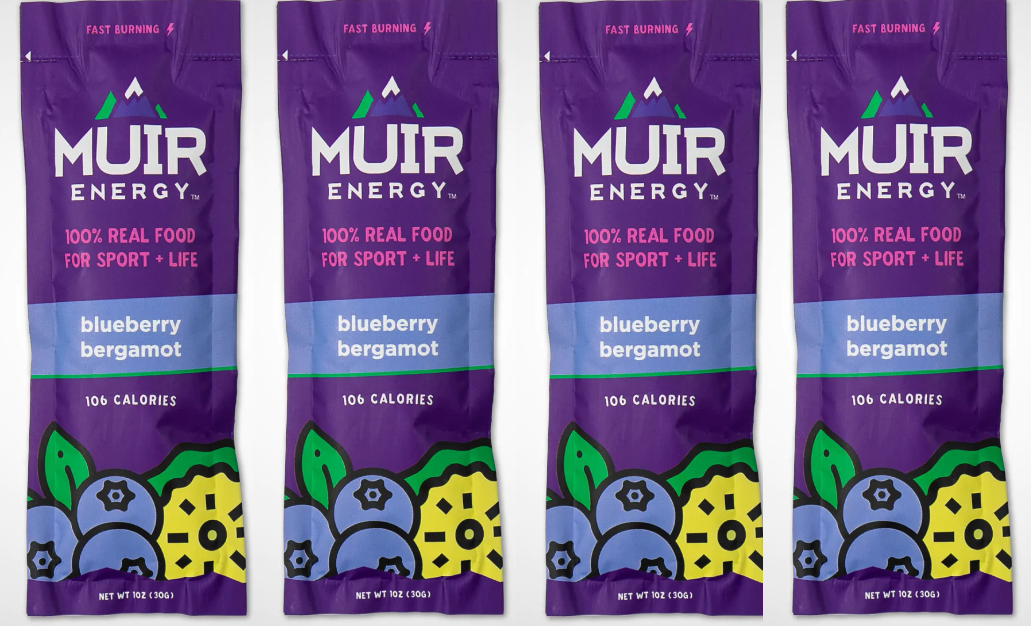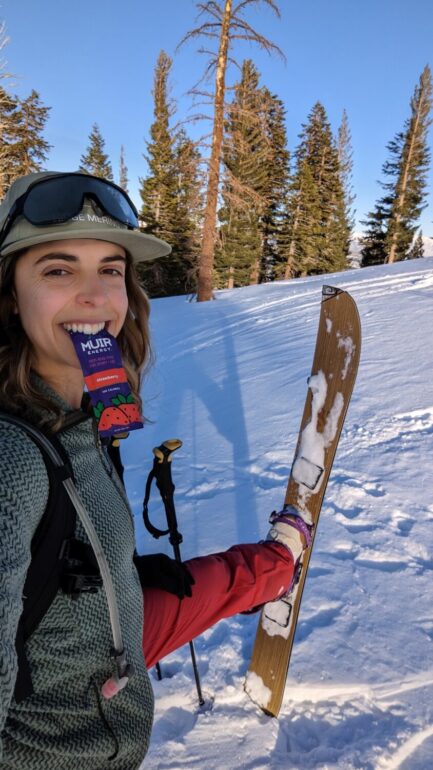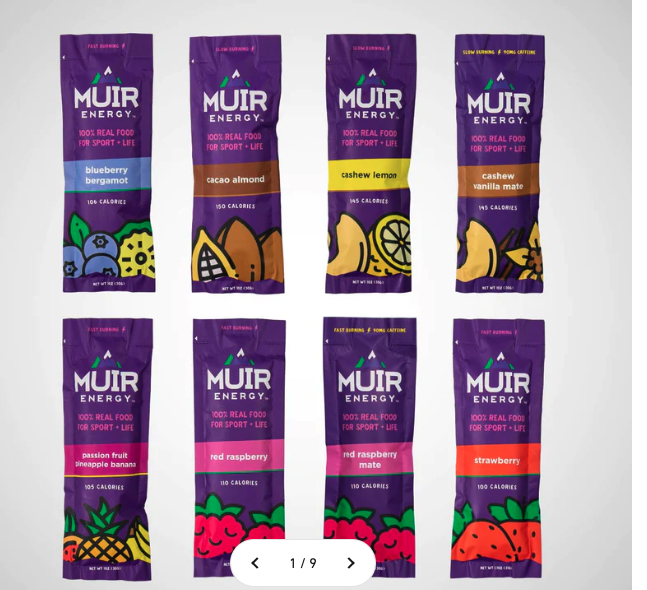
Out of Bounds – E241 – Kings & Kombucha w/ Corey Jackson
Out of Bounds – E241 – Kings & Kombucha w/ Corey Jackson Hello, hello, hello and welcome back to a brand-new episode of The Out Of Bounds podcast, right here […]


Lauren MacLeod, MUIR Energy content editor, and mountain sports dietitian answers your top questions about nutrition for winter athletes. Top 5 Nutrition Tips, incoming.
Between dealing with high altitude, low moisture, and extreme cold, winter athletes have their own unique nutrition needs. In this article we’ll cut through the noise, debunk nutrition myths, and get specific about what you can do to enhance training, increase energy, and optimize recovery, whether you’re touring, taking lifts, nordic skiing, or (dare I say) tele-skiing.
Before a long day in the mountains, it’s necessary to find a balance between nourishing yourself and preventing digestive discomfort. Your energy needs to go up at altitude until you’re fully acclimatized, and pre-fueling ensures you’re starting any adventure strong.
Try to choose snacks that are low in fat and fiber and moderate in protein. These nutrients slow down digestion and may increase gastrointestinal (GI) distress.
Some options include:
If you’re out in the elements for longer than one hour, eat an easy-to-digest snack every hour on the hour. Regular refueling ensures your muscles have a continuous supply of energy to keep you going – and not snapping at your touring partners. See the above examples of pre-training snacks for more ideas.
For tours and adventures that pass the two-hour mark, it’s important to start thinking about protein and fats too. Protein begins the muscle recovery process, while fats are the dense source of calories. Winter training burns incredible calories, and it can be tough to get enough from carbs alone. Consider adding in:
MUIR slow-burning gels
Peanut butter + fruit or jelly sandwich
Trail mix
Nut butter packets
I do not recommend doing ANY fasted exercise unless you’re training for less than one hour. Staying well-nourished is the key to training effectively.
Around the time you’re thinking about apres (30 minutes to 1-hour post-exercise), make a meal or snack that contains carbohydrates and protein. These two nutrients need to work together to build muscle and replenish energy storage–that protein powder won’t do the trick on its own. Need an idea of what to eat after training? Check out my recovery smoothie recipe below.
Some inflammation is normal after exercise, but too much can impact your ability to recover and rest up for your next ski session. Choosing unsaturated fats and omega-3 fatty acids can help with both modulating inflammation and keeping blood sugar balanced so you don’t crash.
Fats also provide long-term energy and more calories to keep you warm and prevent *hanger*.
Recommended fat sources for winter athletes:
MUIR slow-burning gels, which contain nut butter
Nut-based trail mix
Avocado
Plant-based oil (canola, olive, avocado, sunflower seed, sesame)
Fatty fish (salmon, tuna, pollock, catfish)
Staying hydrated can be a big struggle, especially when you add in the elements. Because of the cold winter weather, athletes may not feel the same thirst triggers as they do in summer. However, cold, high-altitude air is extremely dry, making it even easier to get dehydrated in the mountains.
I get it: no one wants to stop every few lifts to hydrate (or relieve themselves of hydration). But dehydration can really put a damper on your day. Some symptoms of dehydration (that don’t include thirst) are trouble focusing, fatigue, and dizziness. You don’t want these issues getting in the way of your adventures! Try to get about half your weight in ounces of fluid per day.
For example, if you weigh 150 pounds, aim for 75 ounces of water per day.
Other sources of fluids include juice, smoothies, soup, and high-water foods like melons, grapes, and cucumbers.
Which of these “Top 5 Nutrition Tips” are most useful for you?
This smoothie contains carbohydrates, protein, fats, and fruits to help athletes recover from training, manage inflammation, and balance energy.
1 medium banana, frozen
1 Ping pong ball-sized scoop of nut butter OR 2 MUIR cashew vanilla slow-burn gels
1 cup milk or milk alternative of choice (soymilk is my personal favorite)
2 scoops chocolate protein powder of choice OR 1 cup plain dairy yogurt and a spoonful of cocoa powder
Blend until smooth.
For more hit http://www.OutofPodcast.com/Blog
Tagged as: muir energy, nutrition.

Out of Bounds – E241 – Kings & Kombucha w/ Corey Jackson Hello, hello, hello and welcome back to a brand-new episode of The Out Of Bounds podcast, right here […]

The Pursuit – EP169 – Just Say it Somebody’s gotta address it, so let’s discuss it. Imagine if we were all just people trying to make our way around this […]

Out of Bounds – E293 – Cody Cirillo Goes for a Long Bike Ride Hello, hello, hello and welcome to a brand-new episode of The Out Of Bounds podcast, right […]

The Pursuit – EP168 – The Tour The Tour de France has begun. The XGL has teamed up with a prominent ski organization. Also, Specialized has announced a new bike, […]
Adam X Sauerwein June 26, 2024
The Pursuit – EP167 – Introducing The League With two major sporting announcements in the past month, AdamX sat down to discuss the XGames League and Shaun White’s new snow […]
© 2022 Out Of Collective
| Cookie | Duration | Description |
|---|---|---|
| cookielawinfo-checkbox-analytics | 11 months | This cookie is set by GDPR Cookie Consent plugin. The cookie is used to store the user consent for the cookies in the category "Analytics". |
| cookielawinfo-checkbox-functional | 11 months | The cookie is set by GDPR cookie consent to record the user consent for the cookies in the category "Functional". |
| cookielawinfo-checkbox-necessary | 11 months | This cookie is set by GDPR Cookie Consent plugin. The cookies is used to store the user consent for the cookies in the category "Necessary". |
| cookielawinfo-checkbox-others | 11 months | This cookie is set by GDPR Cookie Consent plugin. The cookie is used to store the user consent for the cookies in the category "Other. |
| cookielawinfo-checkbox-performance | 11 months | This cookie is set by GDPR Cookie Consent plugin. The cookie is used to store the user consent for the cookies in the category "Performance". |
| viewed_cookie_policy | 11 months | The cookie is set by the GDPR Cookie Consent plugin and is used to store whether or not user has consented to the use of cookies. It does not store any personal data. |
Post comments
This post currently has no comments.